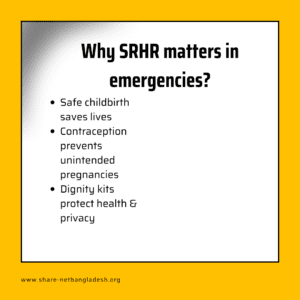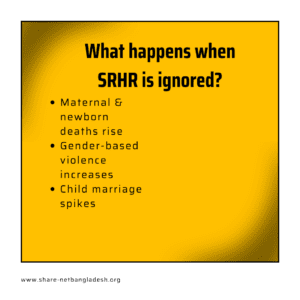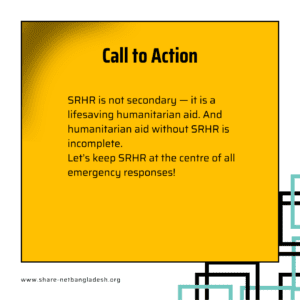Beyond the World Humanitarian Day: Why SRHR in Humanitarian Crises Cannot Wait?
Every year on 19 August, the world observes “World Humanitarian Day” to honour aid workers and raise awareness about the needs of people caught in crises. But for women, girls, and marginalised communities in Bangladesh, humanitarian challenges do not end with the day’s commemoration. As we reflect back, at the end of August, one reality stands out: Sexual and Reproductive Health and Rights (SRHR) remain an overlooked emergency in humanitarian response.
SRHR in Humanitarian Contexts of Bangladesh
Bangladesh is one of the most disaster-prone countries in the world. Floods, cyclones, river erosion, and climate-induced displacement affect millions each year. On top of this, the Rohingya refugee crisis has created one of the largest humanitarian responses globally. Yet, in both natural and man-made emergencies, SRHR often receives insufficient attention.

For women and girls in camps, shelters, and temporary settlements, the needs are urgent:
- Safe pregnancy and childbirth services are often disrupted, leading to preventable maternal and newborn deaths.
- Contraceptives and menstrual hygiene products are scarce, increasing health risks and undermining dignity.
- Gender-based violence (GBV) risks rise sharply, yet survivors often lack confidential and accessible services.
- Young people and adolescents face heightened vulnerabilities, including child marriage and unsafe abortions.

Why is SRHR Humanitarian Aid?
It is sometimes seen that SRHR is a “secondary” issue in humanitarian planning, but in reality, it is lifesaving aid. The Minimum Initial Service Package (MISP) for SRHR in crises, endorsed by UNFPA and WHO, outlines essential actions such as emergency obstetric care, GBV prevention, and access to contraception. When neglected, the consequences are severe and long-lasting.
The Bangladesh Experience

- In the Rohingya camps, UNFPA reported in 2023 that nearly 60,000 babies are born each year, often in unsafe or unhygienic conditions.
- During the 2022 floods in Sylhet, displaced women highlighted the lack of sanitary pads and privacy as one of their greatest struggles.
- A study by BRAC (2021) showed that child marriage spiked during climate disasters, partly due to parents’ fears for girls’ safety in temporary shelters.
These are not isolated issues; they reflect systemic gaps in integrating SRHR into humanitarian preparedness and response.
Looking Forward: Beyond the Day

World Humanitarian Day may have passed, but our collective responsibility remains. SRHR must be recognised as a core part of humanitarian action in Bangladesh. This means:
- Ensuring the MISP is fully integrated into all emergency response plans.
- Strengthening partnerships with grassroots organisations that understand local SRHR needs.
- Investing in women- and youth-led initiatives that provide dignity kits, safe spaces, and community-led solutions.
- Making SRHR data collection and accountability central to humanitarian funding.
The call is simple: Humanitarian aid without SRHR is incomplete. As Bangladesh faces increasing humanitarian challenges, keeping SRHR at the centre is not just about health; it is about dignity, rights, and survival.
📚 Sources / References:
- UNFPA (2023). Rohingya Crisis Response in Bangladesh.
- BRAC (2021). Impact of Climate Change on Child Marriage in Bangladesh.
- Inter-Agency Working Group on Reproductive Health in Crises (IAWG). Minimum Initial Service Package (MISP).
- WHO (2021). Sexual and Reproductive Health in Humanitarian Settings.
- UNICEF Bangladesh (2022). Flood Response: Women and Children’s Needs Assessment.

